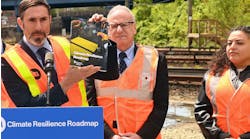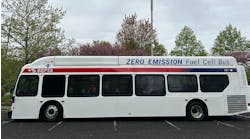- One word to describe yourself: Adventurous
- Favorite TV show: "The Walking Dead" and “How’s stuff made”
- Favorite movie: “Ghostbusters”
- Favorite hobby(ies): Spin Classes at the gym and travelling the world
- Fun fact about yourself: He once rode a bicycle from Angkor Wat, Cambodia to Ho Chi Min, Vietnam.
- What is your favorite transit system (outside of the one you work for or have worked for!) and why?: London Underground. It’s the life blood of the city
Nathan Cornish of Transit Wireless serves as the director of product development and director of RF engineering for one of the most ambitious and challenging projects in the telecommunications industry.
The assignment: to build a wireless communications infrastructure that would connect millions of New York City subway riders via a cellular and Wi-Fi network within the system’s underground subway stations and create a communications network infrastructure to serve transit and public safety communications needs now and into the future. Cornish was hired by Transit Wireless in 2012 as a radio frequency (RF) engineering manager to assist in the design and build of the New York City underground subway project. His skills were quickly recognized by his peers and he was promoted to director of RF engineering in 2013, and director of product development in 2016. Under his leadership, the Transit Wireless team’s work has enhanced the transit experience and improved safety for nearly two billion riders a year.
Transit Wireless was formed to meet the Metropolitan Transportation Authority’s requirement to develop a shared wireless infrastructure within the underground stations of the New York City subway to provide Wi-Fi and commercial cellular services for AT&T, Sprint, T-Mobile and Verizon Wireless customers. The project was a public private partnership with the MTA that Transit Wireless completed nearly two-years ahead of schedule and at no cost to subway riders or New York City taxpayers. From the outset, Cornish and his team at Transit Wireless faced big challenges adapting 21st century technology to create a robust communications infrastructure in an underground transit system over 100 years-old. The network had to be built to withstand extreme temperature, moisture and dust/dirt conditions; provide seamless connectivity from the train platforms, which are as far as 180-feet underground, up to the street; deliver secure 4.9 GHz public safety communications as well as public Wi-Fi and cellular on all four major carriers; and offer scalability to accommodate future transit needs, such as positive train control systems. Add to that, the system had to be installed into 279 stations in a subway system that operates 24/7, and serves more than five million passengers daily.
Cornish, with his technical and leadership skills, were an integral part in the Transit Wireless New York City Subway project. He was widely praised by both colleagues and project partners, including the wireless carriers and vendors, for his unique ability to manage both the technical and business relationship aspects of the project. As Director of the RF Engineering Department at Transit Wireless, Cornish worked with all departments to commission the wireless carriers on the project, and also led the design and development of the RF technology and distributed antenna systems (DAS) networks within each of the 279 underground subway stations. No two stations within the system have the same layout and in many cases, Transit Wireless had to design special equipment to accommodate unique conditions such as low ceiling heights, extreme fluctuations in temperature, and moisture.
"My first point of professional pride is delivering Wi-Fi and Cellular service in the New York City subway with Transit Wireless over 2 years ahead of schedule. I am also proud of being the technical lead on the launch of the first commercial Digital Radio service in Australia (July 2009) for the National Broadcasters. The Digital Radio service was launched in all 5 major capital cities in Australia, enabling high definition audio via the new DAB+ standard."
"I think that what I enjoy about the job the most is bringing new technology to a 100-year-old subway system that had no connection at all, and now we're able to surf the web."
"The thing that I like about being a part of the transit industry is that it is the blood of the city in that everything is kind of connected. Without the subway nothing runs."
"The most challenging part of the position is dealing with the requirements of the transit systems. It's not your everyday office building designing, it's a system that runs 24/hours a day during the week and has very high temperatures and the environments make it very difficult to find equipment to meet the challenge. So finding the solutions that meet the transit environment are different than a normal commercial environment."




